Stages of Colon Cancer and Rectal Cancer
If a biopsy finds that colorectal cancer is present, your doctor will need to know the extent or stage of the disease to recommend the best treatment. The process of staging tells us whether cancer has invaded nearby tissues or if it has spread, and, if so, how far.
Determining the Colorectal Cancer Stage
According to the American Cancer Society, the TNM system, created by the American Joint Committee on Cancer (AJCC), is the most widely used.
TNM stands for:
- T: the size of the tumor and any spread of cancer into nearby tissue
- N: the spread of cancer to nearby lymph nodes
- M: metastasis (spread of cancer to other parts of the body)
Patients are given a T, N, and M status. When combined, they determine the stage of colorectal cancer.
There are 5 stages: stage 0 (zero) and stages I through IV (1 through 4). The stage provides a common way of describing the cancer, so doctors can work together to plan the best treatment.
T Categories for Colorectal Cancer
T, followed by a letter or number (0 to 4), is used to describe how deeply the primary tumor has grown into the bowel lining.
- TX: The primary tumor cannot be evaluated.
- T0: There is no evidence of cancer in the colon or rectum.
- Tis: Refers to carcinoma in situ (also called cancer in situ). Cancer cells have not grown beyond the inner layer (mucosa) of the colon or rectum.
- T1: The tumor has grown into the submucosa— the layer of tissue underneath the mucosa or lining of the colon or rectum.
- T2: The tumor has grown into the muscularis propria, a deeper, thick layer of muscle that is responsible for moving food down the gut.
- T3: The tumor has grown through the outermost layers of the colon or rectum but has not gone through them nor has it reached nearby organs..
- T4a: The cancer has grown through all layers of the colon.
- T4b: The cancer has grown into or has attached to other organs or structures.
N Categories for Colorectal Cancer
N, followed by a letter or number (0 to 2), indicates whether the cancer has spread to lymph nodes near the colon and rectum (called regional lymph nodes).
- NX: The regional lymph nodes cannot be evaluated.
- N0: There is no spread to regional lymph nodes.
- N1a: There are cancer cells found in 1 regional lymph node.
- N1b: There are cancer cells found in 2 or 3 regional lymph nodes.
- N1c: There are nodules made up of tumor cells found in areas of fat near the colon but not the nodes themselves.
- N2a: There are cancer cells found in 4 to 6 regional lymph nodes.
- N2b: There are cancer cells found in 7 or more regional lymph nodes.
M Categories for Colorectal Cancer
M, followed by a letter or number (0 to 1), describes cancer that has spread to other parts of the body, such as the liver or lungs. This is called distant metastasis.
- M0: The cancer has not spread to a distant part of the body.
- M1a: The cancer has spread to 1 other part of the body beyond the colon or rectum.
- M1b: The cancer has spread to more than 1 part of the body other than the colon or rectum.
- M1c: The cancer has spread to distant parts of the peritoneum (the lining of the abdominal cavity). It also may or may not have spread to distant organs or lymph nodes.
Colon and Rectal Cancer Stages
The following chart from the American Cancer Society is helpful in comparing colon and rectal cancer stages and the TNM status.
Stage 0 Colorectal Cancer
The cancer is in its earliest stage and is only detected in the colon or rectum's innermost lining.
Stage grouping: Tis, N0, M0
This stage is also known as carcinoma in situ or intramucosal carcinoma (Tis). It has not grown beyond the colon or rectum's inner layer (mucosa).
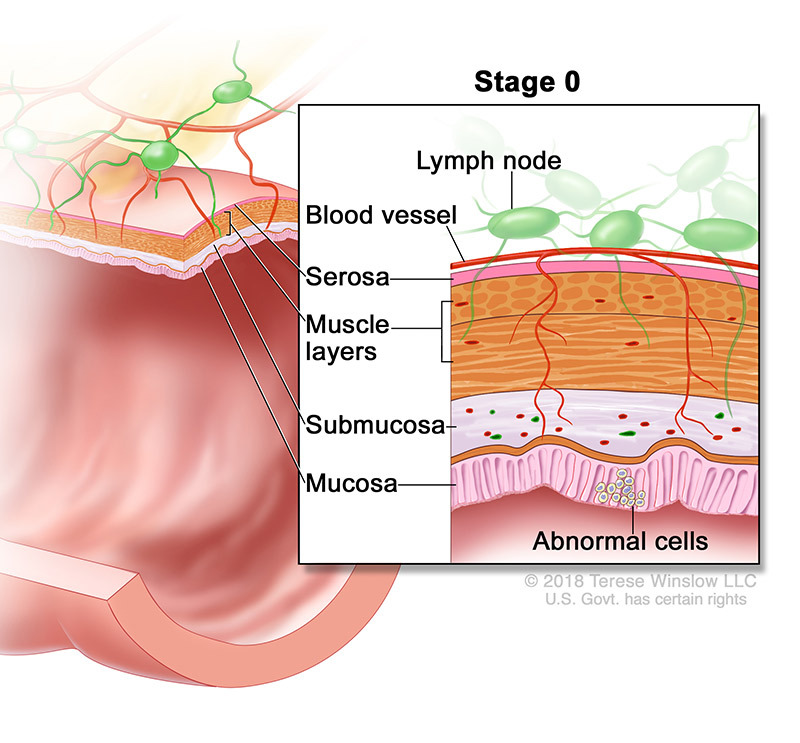
Stage I Colorectal Cancer
Cancer has grown into the colon or rectum's inner wall but has not grown through the wall.
Stage grouping: T1 or T2, N0, M0
The cancer has grown through the muscularis mucosa into the submucosa (T1) and may also have grown into the muscularis propria (T2). It has not spread to nearby lymph nodes (N0) or to distant sites (M0).
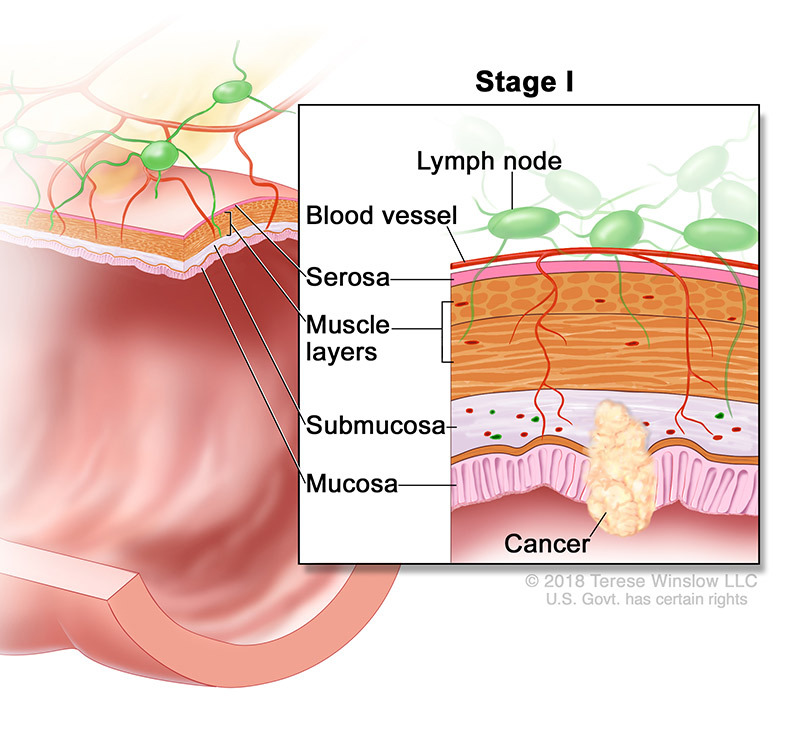
Stage II Colorectal Cancer
The cancer has spread deeply into or through the wall of the colon or rectum, and may have invaded nearby tissue, but the cancer cells have not spread to the lymph nodes.
IIA
Stage grouping: T3, N0, M0
The cancer has grown into the outermost layers of the colon or rectum but has not gone through them (T3). It has not reached nearby organs. It has not spread to nearby lymph nodes (N0) or to distant sites (M0).
IIB
Stage grouping: T4a, N0, M0
The cancer has grown through the wall of the colon or rectum but has not grown into other nearby tissues or organs (T4a). It has not yet spread to nearby lymph nodes (N0) or to distant sites (M0).
IIC
Stage grouping: T4b, N0, M0
The cancer has grown through the wall of the colon or rectum and is attached to or has grown into other nearby tissues or organs (T4b). It has not yet spread to nearby lymph nodes (N0) or to distant sites (M0).
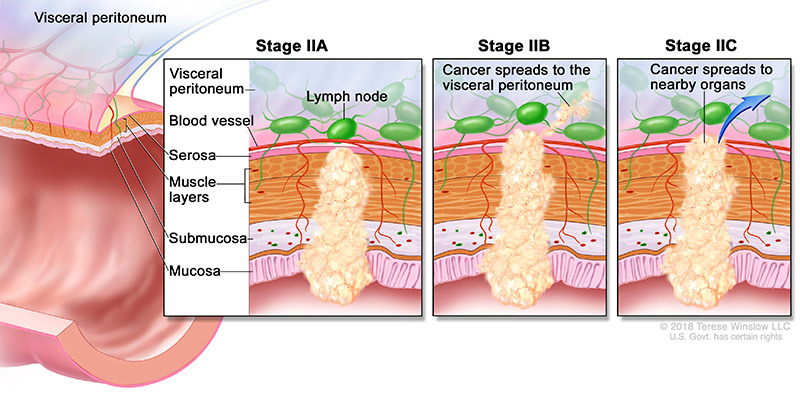
Stage III Colorectal Cancer
The cancer has extended to lymph nodes that are nearby, but has not grown to other parts of the body.
IIIA
Stage grouping: T1 or T2, N1/N1c, M0
The cancer has grown through the mucosa into the submucosa (T1) and may also have grown into the muscularis propria (T2). It has spread to 1 to 3 nearby lymph nodes (N1) or into areas of fat near the lymph nodes but not the nodes themselves (N1c). It has not spread to distant sites (M0).
OR
Stage grouping: T1, N2a, M0
The cancer has grown through the mucosa into the submucosa (T1). It has spread to 4 to 6 nearby lymph nodes (N2a). It has not spread to distant sites (M0).
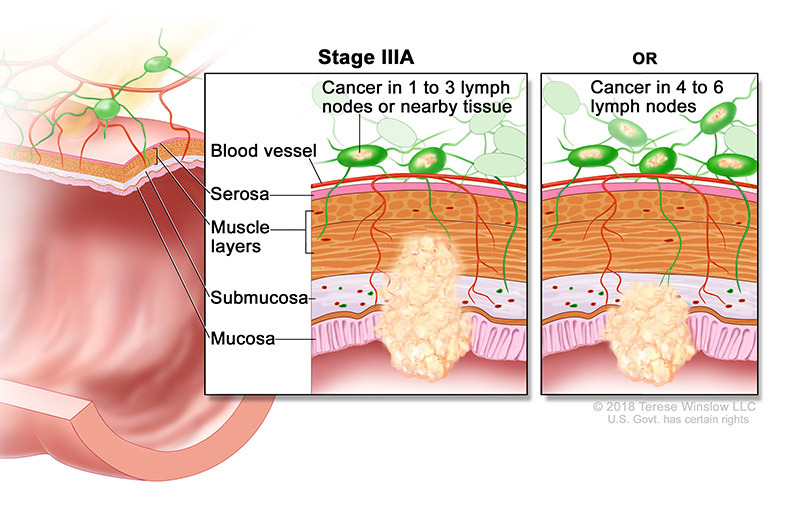
IIIB
Stage grouping: T3 or T4a, N1/N1c, M0
The cancer has grown into the outermost layers of the colon or rectum (T3) or through the visceral peritoneum (T4a) but has not reached nearby organs. It has spread to 1 to 3 nearby lymph nodes (N1a or N1b) or into areas of fat near the lymph nodes but not the nodes themselves (N1c). It has not spread to distant sites (M0).
OR
Stage grouping: T2 or T3, N2a, M0
The cancer has grown into the muscularis propria (T2) or into the outermost layers of the colon or rectum (T3). It has spread to 4 to 6 nearby lymph nodes (N2a). It has not spread to distant sites (M0).
OR
Stage grouping: T1 or T2 N2b, M0
The cancer has grown through the mucosa into the submucosa (T1), and it may also have grown into the muscularis propria (T2). It has spread to 7 or more nearby lymph nodes (N2b). It has not spread to distant sites (M0).
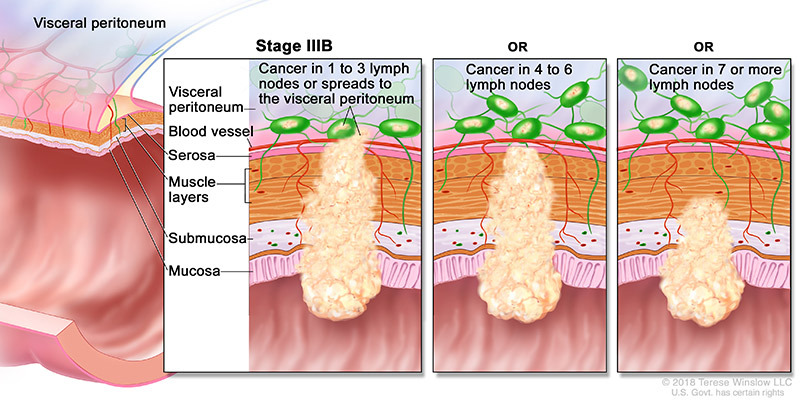
IIIC
Stage grouping: T4a, N2a, M0
The cancer has grown through the wall of the colon or rectum (including the visceral peritoneum) but has not reached nearby organs (T4a). It has spread to 4 to 6 nearby lymph nodes (N2a). It has not spread to distant sites (M0).
OR
Stage grouping: T3 or T4a, N2b, M0
The cancer has grown into the outermost layers of the colon or rectum (T3) or through the visceral peritoneum (T4a) but has not reached nearby organs. It has spread to 7 or more nearby lymph nodes (N2b). It has not spread to distant sites (M0).
OR
Stage grouping: T4b, N1 or N2, M0
The cancer has grown through the wall of the colon or rectum and is attached to or has grown into other nearby tissues or organs (T4b). It has spread to at least one nearby lymph node or into areas of fat near the lymph nodes (N1 or N2). It has not spread to distant sites (M0).
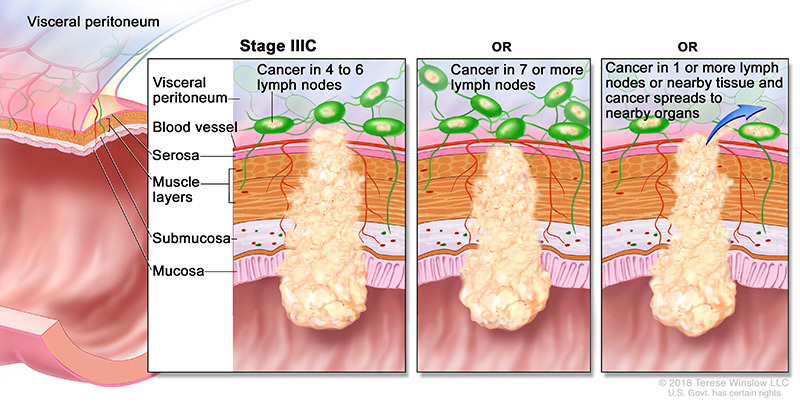
Stage IV Colorectal Cancer
Cancer has spread to other body parts like the liver or lungs.
IVA
Stage grouping: Any T, Any N, M1a
The cancer may or may not have grown through the wall of the colon or rectum (Any T). It might or might not have spread to nearby lymph nodes. (Any N). It has spread to 1 distant organ (such as the liver or lung) or a distant set of lymph nodes but not to distant parts of the peritoneum (the lining of the abdominal cavity) (M1a).
IVB
Stage grouping: Any T, Any N, M1b
The cancer might or might not have grown through the wall of the colon or rectum (Any T). It might or might not have spread to nearby lymph nodes (Any N). It has spread to more than 1 distant organ (such as the liver or lung) or distant set of lymph nodes, but not to distant parts of the peritoneum (the lining of the abdominal cavity) (M1b).
IVC
Stage grouping: Any T, Any N, M1c
The cancer might or might not have grown through the wall of the colon or rectum (Any T). It might or might not have spread to nearby lymph nodes (Any N). It has spread to distant parts of the peritoneum (the lining of the abdominal cavity), and may or may not have spread to distant organs or lymph nodes (M1c).
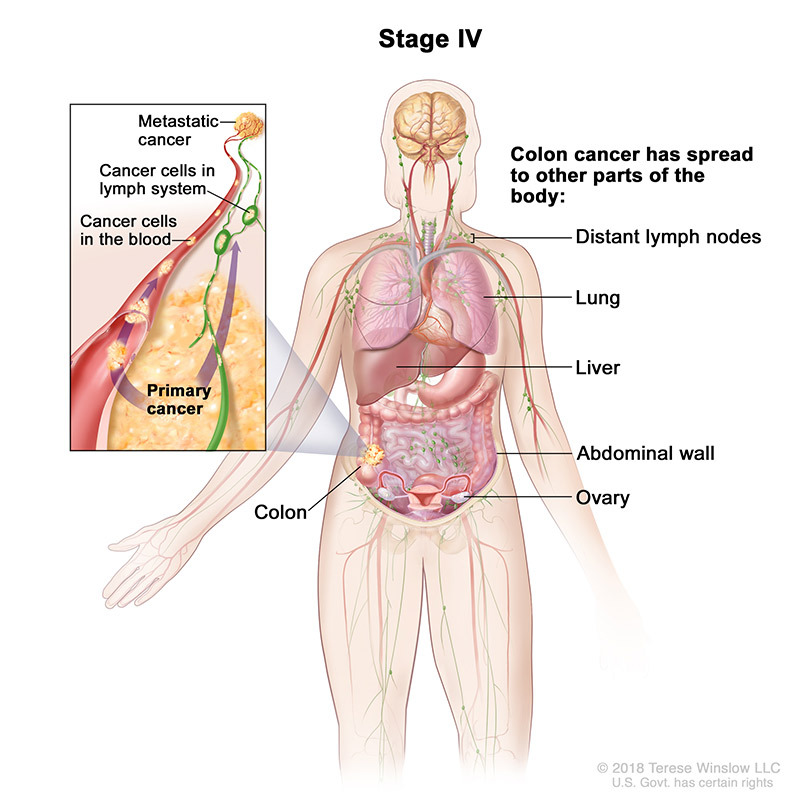
*The following additional categories are not listed above:
- TX: The main tumor cannot be assessed due to a lack of information.
- T0: No evidence of a primary tumor.
- NX: Regional lymph nodes cannot be assessed due to a lack of information.
Colorectal Cancer Recurrence
Cancer that has been treated and returns after a time when cancer could not be detected. The cancer may come back in the colon or rectum or in another body part.
Colorectal Cancer Care in Brevard County
If you have been newly diagnosed with colon or rectal cancer, our team is here to help you through the next steps. Make an appointment with the oncologists at Cancer Cancer Care Centers of Brevard to create a personalized colorectal cancer treatment plan that works for your needs or to get a second opinion. We have cancer centers conveniently located in Palm Bay, Melbourne, Merrit Island, and Rockledge, Florida.